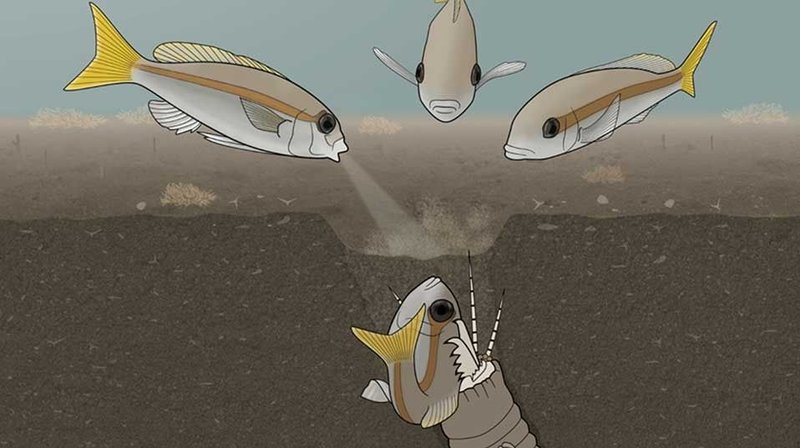
So why should you care about these fascinating predators? Well, documented attacks on large fish by Bobbit worms are not only intriguing but also tell us a lot about marine life dynamics. These events reveal how predators interact with their environment and how they affect the behavior of larger species. If you’re curious about the chaotic dance of predator and prey underwater, this topic is for you. Get comfy, and let’s dive into the world of Bobbit worms and their surprising encounters with large fish.
What Is a Bobbit Worm?
The Bobbit worm, or *Eunice aphroditois*, is a marine polychaete that can grow up to 10 feet long! Imagine a super-flexible piece of spaghetti that’s been dipped in a rainbow of colors. They can be a bit shy, hiding within their burrow in the ocean floor while showing only their head and jaws, which can be as sharp as a knife. This tactic not only helps them stay hidden from prey, but it also protects them from larger predators.
These worms have a unique hunting style that sets them apart. They are ambush predators, which means they wait for the perfect moment to attack. When a large fish swims by, the Bobbit worm uses its speed and agility to snatch its meal with its powerful jaws. This dramatic attack often happens in the blink of an eye, leaving the victim with little chance to escape.
How Do Bobbit Worms Attack Fish?
Bobbit worms have a pretty terrifying setup for catching their dinner. When a fish comes too close, the worm can sense it through vibrations and movements in the water. It’s a bit like a spider waiting for flies in its web. Once the fish is within reach, the Bobbit worm launches itself out of its burrow, snapping its jaws shut around the unsuspecting fish.
The attack happens so quickly that it almost seems like magic. Fish hardly know what hit them! The jaws are incredibly strong, capable of cutting through tough flesh and even bone if necessary. You might be wondering why fish don’t just swim away faster. Well, the element of surprise definitely plays a huge role here.
Documented Attacks on Large Fish
Several marine biologists and divers have witnessed Bobbit worm attacks on large fish, making these events all the more fascinating. For example, there’s a documented case of a Bobbit worm attacking a grouper. The grouper, a sizable fish, swam right into the worm’s territory and ended up losing part of its tail in the process. This not only showcases the Bobbit worm’s hunting prowess but also emphasizes just how vulnerable even big fish can be.
These encounters provide valuable insights into predator-prey relationships in marine ecosystems. When large fish fall victim to Bobbit worms, it can affect the local food chain and ecological balance. If you think about it, a single attack can ripple through the environment, affecting other species that rely on those fish for survival.
Why Are Bobbit Worms Important to Their Ecosystem?
Bobbit worms play a crucial role in maintaining the balance within their habitats. By preying on larger fish, they help control populations and ensure that the ecosystem doesn’t become overrun. This predatory behavior contributes to the health of the marine environment, making Bobbit worms unsung heroes in many ways.
Additionally, they are a food source for specific animals. While they may be fearsome hunters, Bobbit worms can also become part of the diet for creatures like moray eels and larger fish, who are more than willing to take on the challenge of capturing these slippery worms. It’s a complex web of life that showcases how interconnected everything is underwater.
Potential Risks of Bobbit Worm Encounters
While the idea of a Bobbit worm attack might sound thrilling, it does pose certain risks for divers and marine enthusiasts. Divers who explore areas where Bobbit worms are prevalent need to be cautious. Getting too close might provoke a worm to strike, leading to painful injuries.
Fortunately, these incidents are rare, as Bobbit worms usually prefer to stay hidden. However, if you’re out snorkeling or diving, keep an eye on the sand and reef areas where these worms like to burrow. It’s probably best to maintain a respectful distance, just in case.
Bobbit worms truly are one of the ocean’s most captivating—and slightly terrifying—creatures. Their documented attacks on large fish reveal a world of underwater drama that many of us rarely get to witness. Understanding how these predators interact within their ecosystem can deepen our appreciation for marine life, reminding us of the delicate balance that sustains it.
So, next time you’re near the ocean or even watching a nature documentary, remember the hidden world of the Bobbit worm. They may be hidden beneath the sand, but their impact on the thriving underwater community is undeniable. Just like any superhero (or supervillain), they have their role to play in the story of life beneath the waves.

